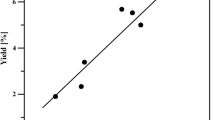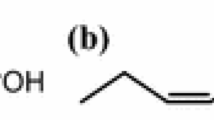Abstract
The solubility of different ethyl esters derivatized from hake liver oil in supercritical carbon dioxide was studied. A selectivity factor was used to determine optimal conditions to fractionate the ethyl ester mixture. A strong influence of solvent pressure and temperature was observed within 8.63–18.04 MPa and 40–70 °C. The lowest total solubility of the ethyl ester mixture was obtained when using supercritical carbon dioxide at the lowest density (the lowest pressure and the highest temperatures value tested). The highest discrimination against long-chain polyunsaturated fatty acids (e.g. EPA and DHA) was also obtained at these above conditions. Conversely, higher solubility and lower selectivity were obtained when solvent density increased. Considering this inverse correlation between selectivity and solubility, a single-step batch-fractionation process was designed to increase the 22:6 ethyl ester content from an initial value of 17.5% in the starting material to 55% in the final extract.




Similar content being viewed by others
References
Staby A, Mollerup J (1993) Solubility of fish oil fatty acids ethyl esters in sub and supercritical carbon dioxide. J Am Oil Chem Soc 70:583–588
Catchpole OJ, Grey JB, Noermark KA (2000) Fractionation of fish oils using supercritical CO2 and CO2–ethanol mixtures. J Supercritical Fluids 19:25–37
Riha V, Brunner G (1999) Phase equilibrium of fish oil ethyl esters with supercritical carbon dioxide. J Supercritical Fluids 15:33–50
Fleck U, Tiegs C, Brunner G (1998) Fractionation of fatty acid ethyl esters by supercritical CO2: high separation efficiency using an automated countercurrent column. J Supercritical Fluids 14:67–74
Liang JH, Yeh AI (1991) Process conditions for separating fatty acids esters by supercritical CO2. J Am Oil Chem Soc 68:687–692
Nilsson WB, Seaborn GT, Hudson JK (1992) Partition coefficients for fatty acid esters in supercritical fluid CO2 with and without ethanol. J Am Oil Chem Soc 69:305–308
Méndez E (1997) Seasonal changes in the lipid classes and fatty acid compositions of hake (Merluccius hubbsi) liver oil. J Am Oil Chem Soc 74:1173–1175
Grompone MA (1992) Aceites de pescado de interés nacional. Ing Quím 3:14–19
Borch-Jensen C, Mollerup J (1999) Phase equilibria of long-chain polyunsaturated fish oil fatty acid ethyl esters and carbon dioxide, ethane, or ethylene at reduced gas temperatures of 1.03 and 1.13. Fluid Phase Equilibria 161:169–189
Acknowledgments
This work was supported by a research grant from the Comisión Sectorial de Investigación Científica CSIC, Universidad de la República, Montevideo, Uruguay.
Author information
Authors and Affiliations
Corresponding author
About this article
Cite this article
Jachmanián, I., Margenat, L., Torres, A.I. et al. Selectivity of Supercritical CO2 in the Fractionation of Hake Liver Oil Ethyl Esters. J Amer Oil Chem Soc 84, 597–601 (2007). https://doi.org/10.1007/s11746-007-1071-3
Received:
Revised:
Accepted:
Published:
Issue Date:
DOI: https://doi.org/10.1007/s11746-007-1071-3




